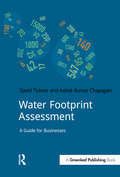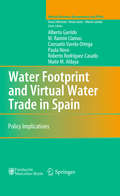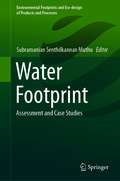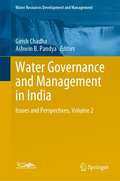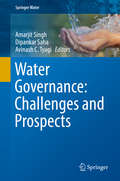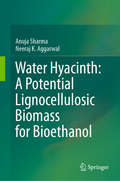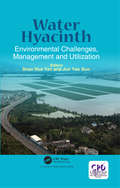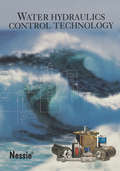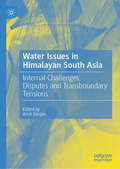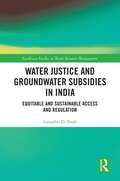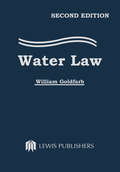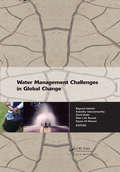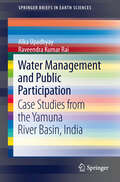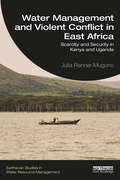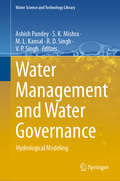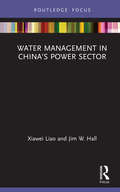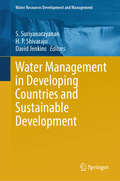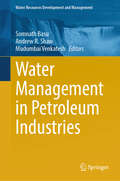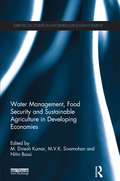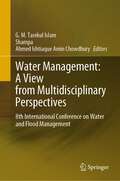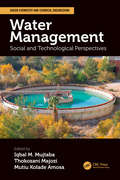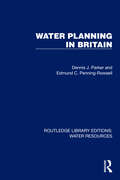- Table View
- List View
Water Footprint Assessment: A Guide for Business (Doshorts Ser.)
by David Tickner Ashok Kumar ChapagainAs business risks associated with water intensify – for example risks to oeprations, supply chains and reputation – many corporate sustainability professionals are seeking practical tools to help them understand and assess these risks. Water Footprint Assessment tools developed primarily by the research sector are gaining attention in this context. However, there is debate among experts and non-experts about the merits of this approach. Water Footprint Assessment: A Business Guide is a concise and comprehensive digest of emerging concepts, tools and arguments around water footprint approaches. Specifically aimed at business audiences, this definitive short guide to the issues distils the latest in scientific and policy literature, helps sustainability leaders understand what they can, and can't do with water footprint tools, includes practical experience and case studies and outlines the pros and cons of using Water Footprint Assessment and similar approaches.
Water Footprint and Virtual Water Trade in Spain
by Maite M. Aldaya Paula Novo Alberto Garrido M. Ramón Llamas Roberto Rodríguez-Casado Consuelo Varela-OrtegaThe evaluation of the water footprint and virtual water trade has become a promising means to evaluate the sustainability of a country's water resources. This book is based on the research and results of a thorough study carried out for Spain, which serves as a leading case for a semi-arid country. The objective of this study was to assess and analyze Spain's virtual water use and water footprint, differentiating the green and blue (surface and groundwater) components, both from a hydrological and economic perspective. This contributes to the water footprint and virtual water literature in several ways. By evaluating both water footprint and virtual water over time and at the provincial scale, the analysis allows for policy-relevant conclusions at the river basin level. By separating green and blue water components, and evaluating all crops at the provincial level, the study enables a finer analysis of how water footprint and virtual water vary during droughts and water shortages. The linkage between commodities trade and water scarcity was explored to determine the extent to which virtual water trade has the potential to deal with water-stressed periods. The analysis contained in this study includes both market and non-market dimensions and will appeal to researchers in both resource economics and hydrology as well as policy-makers concerned with water-related issues.
Water Footprint: Assessment and Case Studies (Environmental Footprints and Eco-design of Products and Processes)
by Subramanian Senthilkannan MuthuThis book highlights the concept of water footprint in different industrial sectors such as leather tanning, steel, agriculture, textile and wine. One of the very basic necessities of life which is soon going to be scarce is water, hence the environmental footprint assessments on any scale essentially includes water footprint which is being measured in various supply chains and across different product categories. According to ISO 14046, the water footprint assessment refers to the total freshwater volume consumed and polluted directly or indirectly across a product’s end-to-end supply chain. This book presents, for industry purposes, the focus on identification and quantification of water trade, the scarcity, and pollution involved in the production of goods and services.
Water Governance and Management in India: Issues and Perspectives, Volume 2 (Water Resources Development and Management)
by Girish Chadha Ashwin B. PandyaThis book, the second volume in the series, continues to raise contextual issues and presents perspectives regarding multifaceted challenges in management and governance of water in India. This volume attempts to broad base and expand the dialogue started in the first volume and would touch upon issues that need immediate discussion but have been left unattended like politics and management of groundwater, efficient utilization of water in agriculture (irrigation) and improving water use efficiency and building resilience. As in the first volume, this book presents a set of suggestions and recommendations in each chapter that can help frame policy guidelines in the country.
Water Governance: Challenges and Prospects (Springer Water)
by Dipankar Saha Amarjit Singh Avinash C. TyagiThe book is the first of its kind to deal with almost the entire swath of water resources assessment, development and sustainable management. The idea of the book crystallized during the long journey of the Editors on various facets of water issues in India and abroad during their extended association, at all levels with the Ministry of Water Resources, River Development and Ganga Rejuvenation, as well as International Organizations dealing with water. Currently water-stressed, India is likely to become water scarce in not too distant a future. The global freshwater supply and its sustainable use for human consumption, and conservation of the ecosystem have never come under such a rigorous scrutiny before. The unplanned and reckless exploitation of this precious resource have led to a crisis situation, compounded by a real threat of climate change. This book is, therefore, timely and of particular relevance not only to India but the entire world. The book contains 20 chapters, beside the lead article by the Editors. The chapters are contributed by the eminent professionals, researchers, academicians and civil society representatives having an in-depth understanding of the issues. The contents of the chapters have been chosen to represent all aspects of water. The assessment of water resources using satellite data and in-depth analyses of groundwater sector like, the Aquifer Mapping Programme initiated by Government of India, application of gravity satellite data to assess the resource build up, artificial recharge of aquifers and its contamination, are dealt with by eminent experts. The articles on sustainable management of water through good governance by community participation and involvement of civil society are placed. Flood management both through a basin level approach as well as by building resilience in vulnerable areas is discussed. Other critical issues like water bodies management, constitutional provisions, water governance and financial issues, hydro-power and need of research and development in this sector are also dealt with aptly. In view of emerging crisis and complexities in this sector the future pathways and the paradigm shift that is required in administrative and policy level is also discussed.
Water Hyacinth: A Potential Lignocellulosic Biomass for Bioethanol
by Neeraj K. Aggarwal Anuja SharmaThis book discusses the production of bioethanol from water hyacinth, a potential source of lignocellulosic biomass. Biofuels, as an alternative to fossil fuels, not only ensure energy security but also mitigate air pollution and reduce greenhouse emissions. Biofuels can be produced from sugar- and starch-rich food crops (first-generation biofuel) or lignocellulosic biomass (second-generation biofuel). However, the overexploitation of conventional lignocellulosic sources such as agro-industrial residues, dedicated herbaceous, hardwoods and softwoods and forest residues may lead to problems in terms of land management and biodiversity conservation. Non-conventional sources include industrial cellulosic waste, municipal solid waste and weeds. Of these, weeds are an attractive lignocellulosic source due to their prevalence and easy availability. Eichhornia crassipes, commonly known as water hyacinth, is one of the world’s most invasive weeds due to its rapid proliferation rate, efficient survival strategies in extreme conditions, and it has a significant impact on the environment, ecological communities, human health and socioeconomic development. Strategies including physical removal, chemical methods and biological control agents have proven inefficient in completely eradicating Eichhornia crassipes. On the other hand, water hyacinth has a low lignin and high holocellulose content and is a rich source of lignocellulosic biomass, and has therefore been exploited as a raw material for the production of biofuel, biogas, animal and fish feed, compost and other valuable products. Further, being an aquatic plant, it does not compete with food crops for land resources. The bioethanol-generating capacity of water hyacinth is comparable to that of agricultural waste, making it a potential raw material for biofuel production.
Water Hyacinth: Environmental Challenges, Management and Utilization
by Shaohua Yan Jun Yao GuoThe water hyacinth is a disruptive factor in aquatic ecosystem management and ecosystem services, and causes problems in fisheries, transportation waterways, irrigation, hydropower generation, and water resources. To address these concerns, it is necessary to integrate past studies with current research and innovations to identify where the knowledge gap is and to creatively assess and solve the problems in a global context. This book provides comprehensive coverage of new research and technological innovations for the application of controlling, managing, harvesting, postharvest processing and utilizing the water hyacinth.
Water Hydraulics Control Technology
by Erik TrostmannThis work introduces the principles of water hydraulics technology and its benefits and limitations, and clarifies the essential differences between water and oil hydraulics. It discusses basic components and systems, including hydraulic power generators (pumps), hydraulic control components or modulators (valves), hydraulic transmission lines (tubes, hoses and fittings) and hydraulic actuators (single- or double-acting cylinders and rotary motors). A listing of water hydraulics components/systems manufacturers is provided.
Water Implications Of Biofuels Production In The United States
by National Research Council of the National AcademiesNational interests in greater energy independence, concurrent with favorable market forces, have driven increased production of corn-based ethanol in the United States and research into the next generation of biofuels. The trend is changing the national agricultural landscape and has raised concerns about potential impacts on the nation's water resources. To help illuminate these issues, the National Research Council held a colloquium on July 12, 2007 in Washington, DC. <i>Water Implications of Biofuels Production in the United States</i>, based in part on discussions at the colloquium, concludes that if projected future increases in use of corn for ethanol production do occur, the increase in harm to water quality could be considerable from the increases in fertilizer use, pesticide use, and soil erosion associated with growing crops such as corn. Water supply problems could also develop, both from the water needed to grow biofuels crops and water used at ethanol processing plants, especially in regions where water supplies are already overdrawn. The production of "cellulosic ethanol," derived from fibrous material such as wheat straw, native grasses, and forest trimmings is expected to have less water quality impact but cannot yet be produced on a commerical scale. To move toward a goal of reducing water impacts of biofuels, a policy bridge will likely be needed to encourage growth of new technologies, best agricultural practies, and the development of traditional and cellulosic crops that require less water and fertilizer and are optimized for fuel production.
Water Issues in Himalayan South Asia: Internal Challenges, Disputes and Transboundary Tensions
by Amit RanjanThe book looks into the domestic water issues and disputes in the Himalayan South Asian countries, and based on it analyzes trans-boundary water disputes. Himalayan South Asia comprises India, Pakistan, Bangladesh, Nepal, Bhutan, and Afghanistan. All except Afghanistan share river waters with India. Home to some of the major river basins of the world, a part of this region falls into water scarce zone, and according to the United Nations Water Report of 2018 some of them will experience severe water scarcity by 2050.The book also studies water issues in China. Though the country is not a part of the Himalayan South Asia, most of the major rivers of this region originate in China. Over the years, China has been alleged by countries like India for diverting, choking or using the trans-boundary river waters for its purpose. Understanding water competition and issues in China will help one to understand its transboundary water behavior.
Water Justice and Groundwater Subsidies in India: Equitable and Sustainable Access and Regulation (Earthscan Studies in Water Resource Management)
by Gayathri D. NaikThis book examines the impact of water-related subsidies on social and distributive equity and environmental sustainability in groundwater access and regulation in India.This book argues that adopting a water justice framework is essential to ensure equitable and sustainable access to and regulation of groundwater by balancing anthropogenic and ecological water needs. The inherent inequity resulting from property rights-controlled groundwater access gets widened by the social, political, and economic factors determining the subsidy beneficiaries. Adopting a socio-legal approach, this book draws on two contrasting case studies in India: Kerala, a water-secure state, and Rajasthan, an arid state. Arguing for a shift to a new paradigm in water governance, it critically examines the feasibility of the public trust doctrine and rights of nature discourse to analyse the best suitable regulatory framework that can balance the human right to water and ecological sustainability in groundwater resources. It demonstrates the feasibility of adopting various environmental law principles that balance human rights to water and nature. It argues that the hitherto highlighted public trust doctrine cannot address these inequities due to its anthropogenic bias and property rights link. This book examines the applicability of the rights of nature discourse instead of these property rights-based regulations to incorporate and mainstream the concerns of aquifer protection in water governance.This book shall be of great interest to students, scholars, and practitioners of water law and policy, environmental law, water and social justice, development studies, and political ecology.
Water Law
by William GoldfarbThis revised second edition is essential to everyone involved with water and water resources-complying with the myriad federal, state, and local laws and regulations that govern the use and management of water in our attempts to maintain, clean, usable water. It includes the law of water diversion and distribution; water resources development and protection; water treatment and land use; ocean dumping; oil and hazardous substances cleanup; riparian and non-riparian systems; Eastern permit systems; beneficial use; water codes; prior appropriation; surface and ground water; channel modifications; municipal water supply; irrigation; California Water Management Districts; Bureau of Reclamation; Corps of Engineers; Water Resources Development Act of 1986; SCS, TVA, BPA, NEA, CERCLA, CWA, SDWA, RCRA, and their substantial changes in the last four years; water resources planning and research; public use; ownership of beds and banks; wild and scenic rivers; river corridor and instream flow protection; flood insurance, Section 404 and Section 208; the Supreme Court and water conservation; heat dischargers; quality-based effluent limitations; state ground water programs; pretreatment; funding; enforcement; citizen suits; and many more vital topics.
Water Loss Assessment in Distribution Networks: Methods, Applications and Implications in Intermittent Supply (IHE Delft PhD Thesis Series)
by Taha M. Al-WashaliWater utilities worldwide lose 128 billion cubic meters annually, causing annual monetary losses estimated at USD 40 billion. Most of these losses occur in developing countries (74%). This calls for rethinking the challenges facing water utilities in developing countries, foremost of which is the assessment of water losses in intermittent supply networks. Water loss assessment methods were originally developed in continuous supply systems, and their application in intermittently operated networks (in developing countries) is hindered by the widespread use of household water tanks and unauthorised consumption. This study provides an extensive review of existing methods and (software) tools for water loss assessment. In addition, several new methods were developed, which offer improved water loss assessment in intermittent supply. As the volume of water loss varies monthly and annually according to the amount of supplied water, this study proposes procedures to normalise the volume of water loss in order to enable water utilities to monitor and benchmark their performance on water loss management. The study also developed a novel method of estimating apparent losses using routine data of WWTP inflows, enabling future real-time monitoring of losses in networks. Different methods have also been suggested to estimate the unauthorised consumption in networks. This study found that minimum night flow analysis can still be applied in intermittent supply if an area of the network is supplied for several days. Furthermore, this study concluded that water meter performance is enhanced in intermittent supply conditions. However, continuous supply in the presence of float-valves significantly reduces the accuracy of water meters. Finally, this study provides guidance and highlights several knowledge gaps in order to improve the accuracy of water loss assessment in intermittent supply. Accurate assessment of water loss is a prerequisite for reliable leakage modelling and minimisation as well as planning for, and monitoring of water loss management in distribution networks.
Water Management Challenges in Global Change: Proceedings of the 9th Computing and Control for the Water Industry (CCWI2007) and the Sustainable Urban Water Management (SUWM) conferences, Leicester, UK, 3-5 September 2007
by Bogumil Ulanicki; Kalanithy Vairavamoorthy; David Butler; Peter L.M. Bounds; Fayyaz Ali MemonWater Management Challenges in Global Change contains the proceedings of the 9th Computing and Control for the Water Industry (CCWI2007) and the Sustainable Urban Water Management (SUWM2007) conferences. The rationale behind these conferences is to improve the management of urban water systems through the development of computerbased methods. Issues such as economic globalisation, climate changes and water shortages call for a new approach to water systems management, which addresses the relevant technical, social and economic aspects. This collection represents the views of academic and industrial experts from a number of countries, who provide technical solutions to current water management problems and present a vision for addressing the global questions. The themes underlying many of the contributions include energy and material savings, water savings and the integration of different aspects of water management. The papers are grouped into three themes covering water distribution systems, sustainable urban water management and modelling of wastewater treatmentplants.The water distribution topics cover asset and information management, planning, monitoring and control, hydraulic modelling of steady state and transients, water quality and treatment, demand and leakage management, optimisation, design and decision support systems, as well as reliability and security of water distribution systems. The sustainable urban water management topics include urban drainage systems, water reuse, social aspects of water management and also selected facets of water resources and irrigation. Computer control of wastewater treatment plants has been seen as less advanced than that of clean water systems. To address this imbalance, this book presents a number of modelling techniques developed specifically for these plants.Water Management Challenges in Global Change will prove to be invaluable to water and environmental engineering researchers and academics; managers, engineers and planners; and postgraduate students.
Water Management Innovations in England (Routledge Revivals)
by Lyle E. CraineAs pressures on water resources have increased, problems of water quality have claimed high priority in national concern and governmental policy. In this book, first published in 1969, Lyle E. Craine describes how Great Britain enacted new governmental procedures for studying, planning, and executing water management programmes. Although the physical and social characteristics of the United States’ water resources problems differ from those of England, this analysis of the British institutional arrangements for water management suggests constructive insights for managing water resources within the individual states. This title is a valuable resource for students interested in environment and sustainability issues, national water resources problems, and government policy making.
Water Management and Public Participation
by Alka UpadhyayIntegrated Water Resources Management (IWRM) is an approach that promotes the coordinated development and management of water, land and related resources, in order to maximize economic and social welfare in an equitable manner without compromising the sustainability of vital ecosystems. Without public interest and participation, successful implementation of IWRM plans for river basin cannot be possible. Further to this, management at the watershed level to assure water supplies to support livelihood (i.e. domestic water, irrigation, industries, etc.) and sustainable groundwater development requires water augmentation through water conservation structures, and pollution control will also play a vital role. In India, because of limited period of rainfall during Monsoon (i.e. three to four months), water conservation and rainwater harvesting have been practiced since ancient days in order to meet water demands throughout the year. These structures are generally constructed and operated through the public participation. Keeping in view of the importance of public partnership, the role of public partnership in context of water-related awareness and practices has been investigated in different parts of the Yamuna River basin. The investigation evaluates the impact of various water conservation devices on livelihood; compares the performance of recently developed water conservation structures with ancient structures; examines spatial variation of water-related problems in the basin; and proposes an institutional setup for effective governance.
Water Management and Violent Conflict in East Africa: Scarcity and Security in Kenya and Uganda (Earthscan Studies in Water Resource Management)
by Julia Renner-MugonoThis book examines the complex interrelationships between water availability, governance and violent and non-violent conflicts, drawing on in-depth case studies of Lake Naivasha in Kenya and Lake Wamala in Uganda. When international economic endeavours like flower farming, oil exploration and extensive rice growing are coupled with a government's prioritization of economic development, not only does this lead to the commercialization of water resources but it also creates conflicts between national, regional and local stakeholders. Often overlooked in existing literature, such is the case even in water abundant areas like Lake Naivasha and Lake Wamala. Presenting a comparative study, the book provides a unique perspective on multifunctional water use and illustrates how politically and economically motivated water use increases violent tensions over access to and the use of freshwater resources. The coverage stretches from international and national agencies to NGOs, economic stakeholders and local actors. The book evaluates the resilience and vulnerability of local actors' ability to access water and examines the nexus between the need to access water and the ability to influence access to water, taking into consideration both countries’ economic development agendas. The book concludes by discussing strategies for reducing water-induced conflicts that can be applied to not only these cases but water conflicts across the globe. This book will be of great interest to scholars and professionals of water resource management and governance, African development, conflict resolution and sustainable development.
Water Management and Water Governance: Hydrological Modeling (Water Science and Technology Library #96)
by V. P. Singh Ashish Pandey S. K. Mishra M. L. Kansal R. D. SinghThis book focusses on hydrological modeling, water management, and water governance. It covers the applications of remote sensing and GIS tools and techniques for land use and land cover classifications, estimation of precipitation, evaluation of morphological changes, and monitoring of soil moisture variability. Moreover, remote sensing and GIS techniques have been applied for crop mapping to assess cropping patterns, computation of reference crop evapotranspiration, and crop coefficient. Hydrological modeling studies have been carried out to address various issues in the water sector. MODFLOW model was successfully applied for groundwater modeling and groundwater recharge estimation. Runoff modeling has been carried out to simulate the snowmelt runoff together with the rainfall and sub-surface flow contributions for snow-fed basins. A study has been included, which predicts the impact of the land use and land cover on stream flow. Various problems in the water sector have been addressed employing hydrological models such as SWAT, ArcSWAT, and VIC. An experimental study has been presented wherein the laboratory performance of rainfall simulator has been evaluated. Hydrological modeling studies involving modifications in the curve number methodology for simulation of floods and sediment load have also been presented. This book is useful for academicians, water practitioners, scientists, water managers, environmentalists, and administrators, NGOs, researchers, and students who are involved in water management with the focus on hydrological modeling, water management, and water governance.
Water Management in China’s Power Sector (Earthscan Studies in Water Resource Management)
by Jim W. Hall Xiawei LiaoThis book examines water resource management in China’s electric power sector and the implications for energy provision in the face of an emerging national water crisis and global climate change. Over 75% of China’s current electricity comes from coal. Coal-fired power plants are reliant on water, with plants using significant volumes of water every year, yet water resources are unevenly distributed. In the face of serious environmental concerns and increasing electricity demand, this book examines the environmental impacts that coal power plants have on water resources and the impact water availability has on the electricity sector in a country with a significant number of water-scarce provinces and a large number of power plants located on inland waterways. It discusses the water impacts and constraints for transforming the electric power sector away from coal to renewable energy sources, such as hydropower and concentrated solar power. The book adopts a mix-method approach, combining a plant-level quantitative analysis on water impacts and dependencies in China’s electricity sector and a qualitative analysis of relevant institutions in both sectors. By reviewing policy and institution cases in China’s water and electricity sectors, the book provides important recommendations calling for coordinated institutions to shift away from the current paradigm where water and electricity are governed independently. Enriching the water-energy nexus literature, this book will be of great interest to students and scholars working on water resource management, energy industries and Chinese environmental policy, as well as policymakers and practitioners in those fields.
Water Management in Developing Countries and Sustainable Development (Water Resources Development and Management)
by David Jenkins S. Suriyanarayanan H. P. ShivarajuThis book provides information on sustainable water resource management strategies that present innovative ways to conserve both quality and quantity of water in developing countries. The book comprises of 24 chapters contributed by authors from 14 countries, namely, Cameroon, China, Cyprus, India, Indonesia, Italy, Namibia, the Netherlands, Norway, Portugal, South Africa, the United Kingdom, the United States of America and Zimbabwe. This book will be of great interest to researchers, practitioners, water resource managers, policy and decision makers, international institutions, governmental and non-governmental organizations, educators, as well as students.
Water Management in Petroleum Industries (Water Resources Development and Management)
by Somnath Basu Andrew R. Shaw Mudumbai VenkateshThis book provides a roadmap for sustainable development and growth of petroleum industry with respect to water usage and discharge. Water and energy are intricately tied with each other. As a major source of conventional energy, petroleum industries— upstream, midstream, and downstream—are collectively large consumers of water. Increasing water stress in major parts of the world has made the industry aware of the impact of usable water on different sectors of petroleum industry, e.g., exploration and production, refining and fuel processing. Treatment of wastewater effluents to maximize reuse is becoming a primary objective of the industry. This, coupled with the need to minimize discharge of contaminants in the effluents that affect human and aquatic life, and the environment at large at reasonable cost is emerging as an important consideration facing the petroleum industry for its sustainable development and growth in the future decades. This book discusses in detail: Sources of water consumed by petroleum production and processing, and wastewater produced Health and environmental effects of chemicals contained in effluent streams Effluent treatment processes—current and new innovations, and technologies for reuse
Water Management, Food Security and Sustainable Agriculture in Developing Economies (Earthscan Studies in Water Resource Management)
by M. Dinesh Kumar Nitin Bassi M. V. K. SivamohanThis book addresses strategies for food security and sustainable agriculture in developing economies. The book focuses primarily on India, a fast developing economy, whose natural resource base comprising land and water supporting agricultural production is not only under enormous stress, but also complex and not amenable to a uniform strategy. It critically reviews issues which continue to dominate the debate on water management for agricultural and food production. The book examines the validity of the claim that large water resources projects cause serious social and environmental damages using global and national datasets. The authors examine claims that the future of Indian agriculture is in rain-fed farming supported by small water harvesting. They question whether water-abundant eastern India could become the granary of India, through a groundwater revolution with the right policy inputs. In the process, they look at the less researched aspect of the food security challenge, which is land scarcity in eastern India. The book analyzes the physical, economic and social impacts of large-scale adoption of micro irrigation systems, using a farming system approach for north Gujarat. Through an economic valuation of the multiple use benefits from tank systems in western Orissa, it shows how value of water from large public irrigation systems could be enhanced. The book also looks at the reasons for the limited success in bringing about the much needed institutional reforms in canal irrigation for securing higher productivity and equity using case studies of Gujarat, Madhya Pradesh and Maharashtra. Finally it addresses how other countries in the developing world, particularly Sub-Saharan Africa could learn from Indian experience.
Water Management: 8th International Conference on Water and Flood Management
by Ahmed Ishtiaque Amin Chowdhury G. M. Tarekul Islam ShampaThis book brings together a selection of best papers from The International Conference on Water and Flood Management, Bangladesh, 2021. The book chapters are based on contributions from multidisciplinary fields, such as nature-based solutions, hydro-meteorological forecasting, river restoration, coastal risk, episodic natural hazards, water risk and resilience, climate-resilient infrastructure, blue economy, and water management during the COVID-19 pandemic.With changing physical and socioeconomic risks due to changes in climate and anthropogenic interventions, integrated approaches to analyzing these processes and their interactions, along with integrating nature-based solutions, are gaining traction. With this special focus on science, policy, and practice to ensure sustainability in the water sector, the conference provided a platform for researchers, policymakers, and practitioners to exchange their knowledge and experience.
Water Management: Social and Technological Perspectives (Green Chemistry and Chemical Engineering)
by Thokozani Majozi Iqbal M. Mujtaba Mutiu Kolade AmosaExponential growth in population and improved standards of living demand increasing amount of freshwater and are putting serious strain on the quantity of naturally available freshwater worldwide. Water Management: Social and Technological Perspectives discusses developments in energy-efficient water production, management, wastewater treatment, and social and political aspects related to water management and re-use of treated water. It features a scientific and technological perspective to meeting current and future needs, discussing such technologies as membrane separation using reverse osmosis, the use of nanoparticles for adsorption of impurities from wastewater, and the use of thermal methods for desalination. The book also discusses increasing the efficiency of water usage in industrial, agricultural, and domestic applications to ensure a sustainable system of water production, usage, and recycling. With 30 chapters authored by internationally renowned experts, this work offers readers a comprehensive view of both social and technological outlooks to help solve this global issue.
Water Planning in Britain (Routledge Library Editions: Water Resources)
by Dennis J. Parker Edmund C. Penning-RowsellOriginally published in 1980, this book provides a penetrating and scholarly analysis of the planning of water resources, based on 10 years’ of research into one of Britain’s most vital industries. At the time of original publication Britain had a plentiful natural supply of water, but accessible clean water was scarce; droughts were not uncommon, floods often caused considerable damage; water bills were rising dramatically and consumption increasing inexorably. All of which applies as much to water resources in the UK today. Water planners must strike a delicate balance between many conflicting social, environmental, political and financial demands. Britain’s water authorities are large and autonomous organisations subject to constant change and controversy. Water policies affect not only water but also land-use planning, recreation planning, environmental quality, food production and the maintenance of public health. The book explains common threads and issues in the planning of 4 main water functions: water supply, effluent disposal and pollution control, water recreation and amenity and land drainage and flood alleviation. 11 original British case studies have been selected to illustrate the issues involved. The final chapter presents a critical and controversial evaluation of water policy and planning institutions in Britain, highlighted by some international comparisons.
